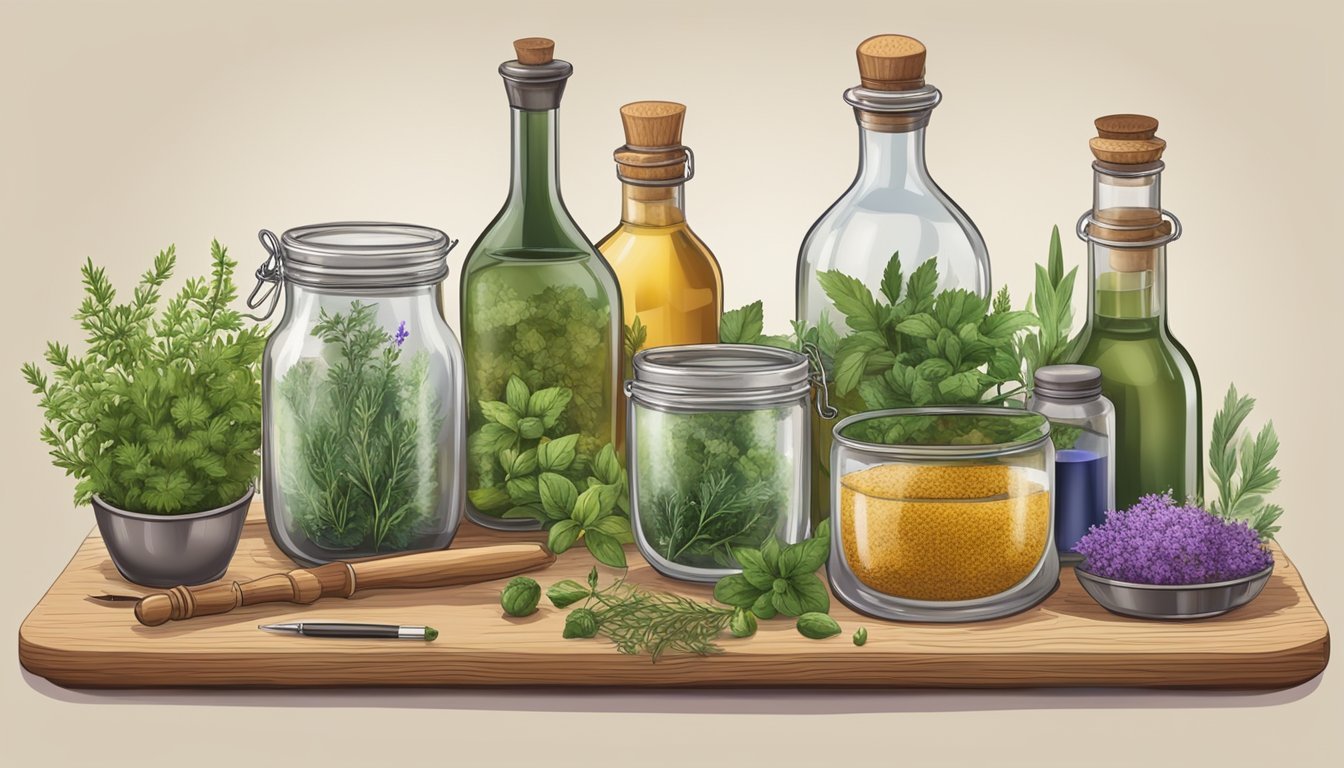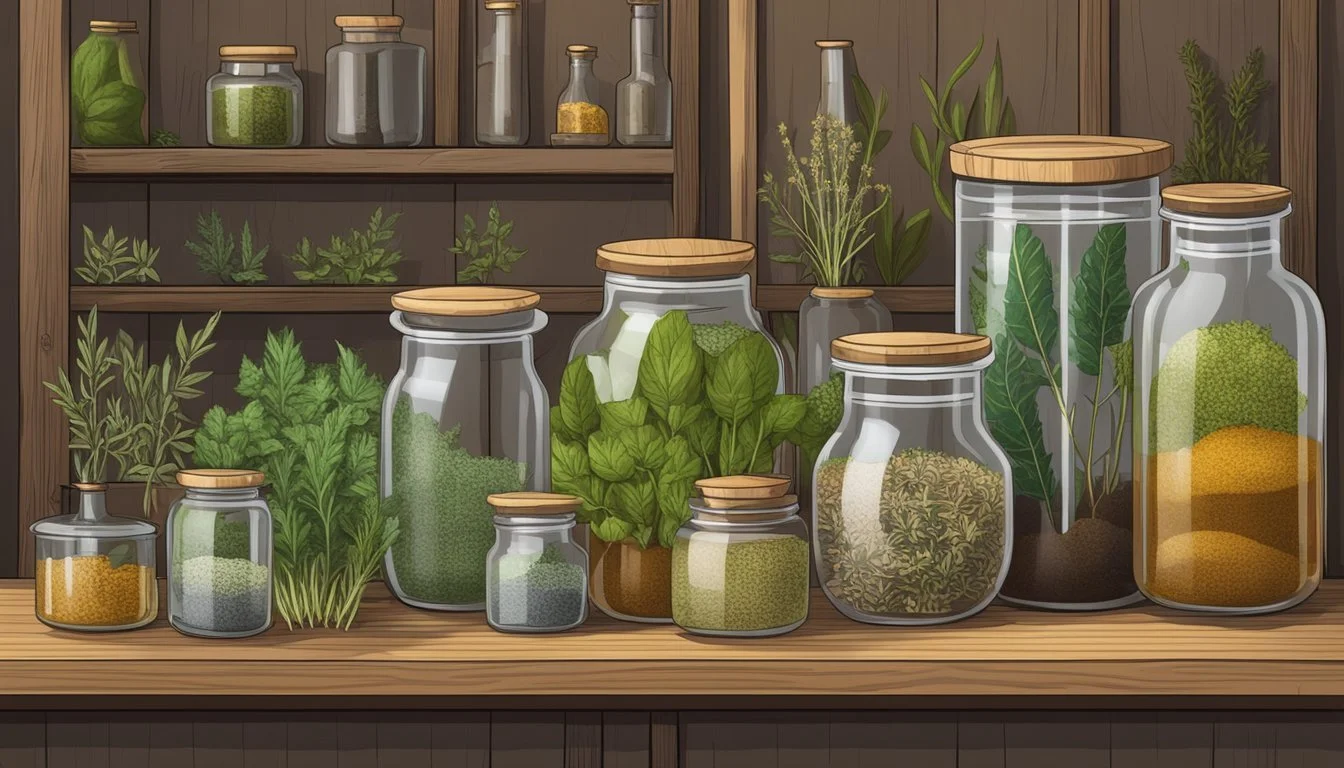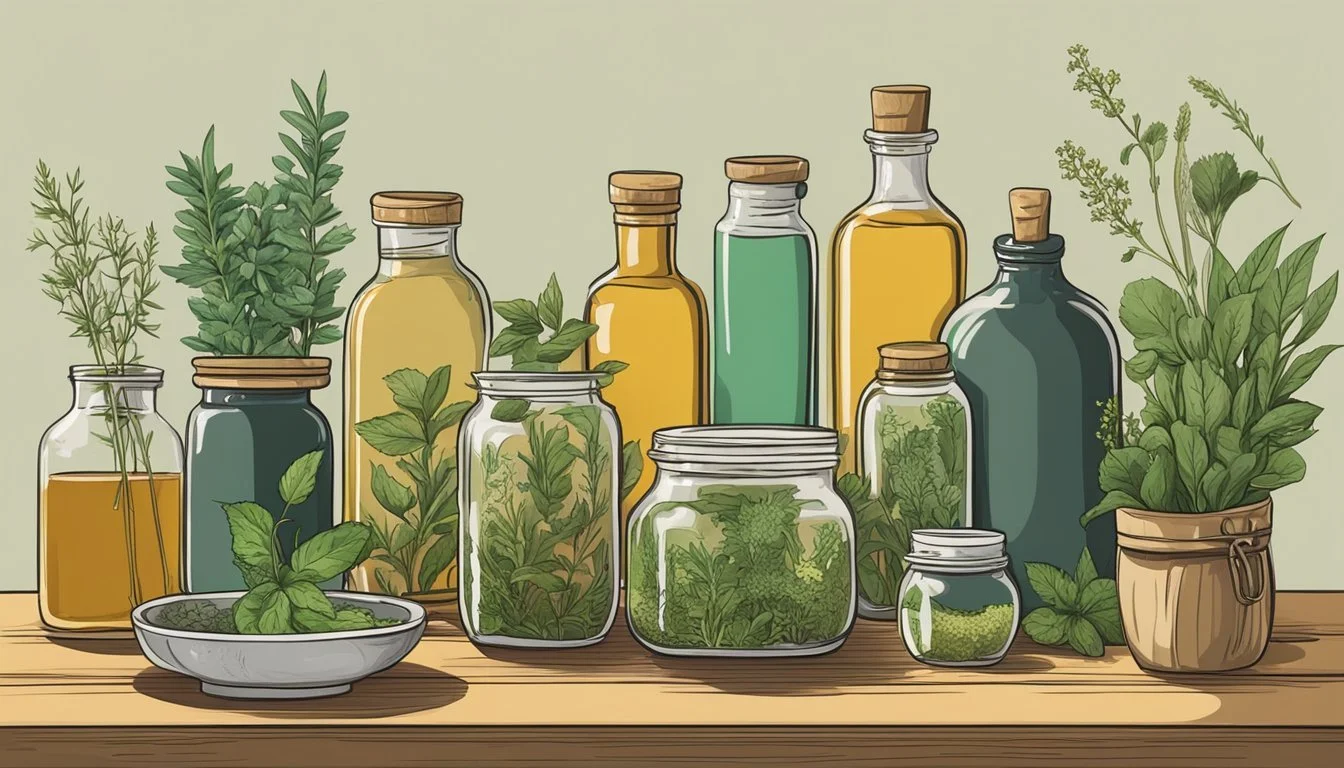How to Make Herbal Tinctures
A Step-by-Step Guide
Herbal tinctures are concentrated extracts made by steeping herbs in alcohol. This process, honed over centuries, involves macerating plant material to extract medicinal constituents. These extracts offer a potent, convenient method for utilizing herbs, with longer shelf life than fresh herbs (how long do fresh herbs last?) or teas. They are preferred for their ease of use, precise dosage, and rapid assimilation into the body, making them a staple in many herbalists' remedies.
The creation of a tincture begins with he selection of high-quality fresh or dried herbs (how long do dried herbs last?) and a suitable solvent like high-proof alcohol. The ratio of herbs to alcohol depends on the specific herb's qualities and desired strength. The mixture is submerged in alcohol, sealed, and infused for a few weeks to several months.
After steeping, the solid herb particles are removed, leaving a potent herbal extract. This extract can be administered under the tongue or diluted in water.
This kind of herbal remedy is known for its long shelf life, typically maintaining potency for several years when stored properly. It is a practical choice for continuous health support and a natural supplement in one's wellness arsenal.
Understanding Herbal Tinctures
A herbal tincture is a concentrated extract that harnesses the beneficial properties of medicinal herbs. It offers a convenient and effective way to utilize the actions and constituents of herbs.
History and Basics
These herbal solutions have a rich history spanning centuries of traditional plant medicine. A tincture typically involves steeping plant material, such as leaves, roots, bark, or berries, in alcohol, which acts as a solvent to extract the active constituents from the herb.
Key elements in tincture making:
Alcohol: Usually high-proof ethyl alcohol is used due to its efficiency in extracting a wide range of soluble compounds.
Herbs: Both fresh and dried herbs can be used, with consideration of their specific properties and desired therapeutic actions.
Ratio: The typical ratio of herb to alcohol varies depending on the potency of the plant material and the manufacturer's preference.
Time: The mixture is left to macerate for several weeks to ensure optimal extraction of medicinal compounds.
Benefits and Uses
Tinctures are essential medicinal herbs that preserve their potency for extended periods. They are convenient, quick to absorb, and customizable. They can have anti-inflammatory, calming, or tonic effects and are used for health issues like digestive function, sleep promotion, and stress reduction. However, benefits will depend on the specific herb or herbs tinctured as well as the herb blend. Users should consult healthcare professionals before incorporating this herbal medicine into their regimen.
Selecting Your Ingredients
The foundation of a potent herbal tincture lies in selecting high-quality herbs and understanding their unique properties. To make an herbal tincture, knowledge of plant parts, whether dried or fresh and their specific uses are crucial.
Choosing Quality Herbs
When selecting herbs, opt for organic or wildcrafted sources to ensure they are free from contaminants. If you have a herb garden, don't use pesticides.
Often, herbalists prefer dried herbs as they have a longer shelf life and concentrated properties. However, if using fresh plant material, ensure the parts are clean and free from mold or decay. For different plant parts:
Flowers and leaves should be vibrant in color and aroma.
Roots and barks must be well-dried, firm, and free from any signs of rot.
Berries and resins should be full, unbroken, and exhibit their characteristic sheen.
Fresh plants can be harvested at specific times to maximize their potency—for instance, flowers are best picked just before they are fully open. Leaves are typically harvested before the morning dew has dried as this is when the concentration of volatile oils is highest in fresh leaves. Roots tend to be collected either in the spring or fall when the plant's energy is concentrated below ground.
Understanding Plant Properties
Each plant part harbors different properties and benefits:
Leaves and flowers are typically used for their delicate oils and are suited for targeting specific ailments.
Roots, barks, and resins are generally more robust and are used for deep-seated, systemic effects due to their concentrated active compounds.
Berries offer a combination of nutritional and medicinal properties, containing both vitamins and active herbal constituents.
It's important to understand the desired outcome of the herbal medicine—some plants are calming while others can be stimulating, some are used for their antiviral properties, and others may support digestion or the circulatory or immune system. A thorough knowledge of plant constituents and each herb's action helps in creating a tincture tailored to specific health needs.
Tincture Solvents
Tincture solvents are fluids used to extract the medicinal components from herbs. The choice of solvent affects the tincture's potency, shelf life, and suitability for different individuals.
Alcohol-Based Solvents
Alcohol tinctures are the most common solvent due to their extraction capabilities and preservative properties. High-proof alcohol like vodka or brandy is commonly used due to its ability to extract water-soluble and alcohol-soluble compounds from plants.
Vodka is preferred due to its neutral flavor and affordability and its alcohol strength. The proof of alcohol used usually ranges from 80 proof (40% alcohol by volume) to as high as 190 proof (95% alcohol by volume). Alternatives like rum or brandy can be used, each adding a unique flavor profile to the tincture.
Recommended Alcohol-Based Solvents:
Vodka (80-100 proof for a balance of alcohol and water)
Brandy (80 proof, offering a sweeter taste)
Rum (high-proof, for a stronger extraction)
Non-Alcohol Solvents
Non-alcohol solvents like vinegar, glycerin, and oil are used by those who avoid alcohol for health, personal, or religious reasons. Apple cider vinegar (how long does apple cider vinegar last?) and distilled white vinegar offer health benefits and extraction abilities, but are less efficient than alcohol.
Vegetable glycerin preserves tinctures and extracts water-soluble constituents but is less effective with alcohol-soluble compounds.
Oil is suitable for topical applications, while water is suitable for fresh herb extractions but has a shorter shelf life and weaker extract.
Preparation Methods
When creating your own herbal tinctures, you can select from various methods, but two of the most popular approaches are the Folk Method and the Weight-to-Volume Ratio method. Each technique is designed to extract the active compounds from herbs efficiently while maintaining simplicity in the process.
Folk Method
The Folk Method is a traditional method for making tinctures, focusing on simplicity and accessibility. It involves filling a glass jar with dried, fresh, or powdered herbs and then using 80-proof alcohol to submerge them. A funnel is used to minimize spillage. The jar is sealed, stored in a cool, dark place, and shaken daily for maceration, typically for 6-8 weeks. The tincture is then strained and stored for use.
Weight-to-Volume Ratio
The Weight-to-Volume Ratio method is a precise technique for determining the strength of tinctures. It involves measuring herbs by weight (in grams) and alcohol by volume (in milliliters), with a common ratio of 1:5. The process involves combining herbs and alcohol in a jar, sealing, storing, shaking, and allowing the mixture to macerate for several weeks before straining. This method is ideal for consistency in tincture strength.
Creating the Tincture
To make an herbal tincture, you must mix and macerate the selected herbs in a liquid to extract their medicinal properties, before using the mesh strainer to strain the mixture and then storing the resultant tincture properly for use.
Mixing and Macerating
For the tincture-making process, one begins by selecting the appropriate herbs. Some common herbs used include echinacea for its immune system support, chamomile for its calming properties, lemon balm for promoting sleep, witch hazel for its anti-inflammatory properties, and lavender for relaxation. Fresh or dried herbs can be used; dried herbs are typically preferred as they're less likely to cause fermentation or mold.
One places a few drops of the herbs in a clean, dry glass jar, observing the following general proportions:
For dried herbs: A common ratio is 1 part herb to 5 parts liquid.
For fresh herbs: A stronger ratio of 1 part herb to 2 parts liquid is often used, due to their higher water content.
High-proof alcohol is commonly used to extract active compounds and act as a preservative, but glycerin or vinegar can be substituted. Place herbs in a jar, cover with the chosen liquid, and shake daily for maceration. The maceration period can range from two to six weeks, depending on the herb and desired tincture strength.
Straining and Storing
After the maceration phase is complete, the next step is to separate the liquid herbal extract from the solid plant material. To accomplish this, one requires a cheesecloth or a fine mesh strainer. The straining process is done as follows:
Place the cheesecloth or strainer over a large bowl.
Pour the tincture along with the herbs into the cheesecloth or strainer.
Gather the edges of the cheesecloth or press down with a spoon to extract as much liquid as possible.
The resulting liquid is the tincture. It should be transferred into amber or dark blue glass bottles to protect it from light, which can degrade the quality. These bottles should be labeled with the name of the tincture and the date of completion. When stored correctly in a cool, dark place, homemade tinctures can last for several years.
Dosage and Administration
Proper dosing of tinctures is vital to ensuring efficacy while minimizing the risk of adverse effects. The methods of administration offer flexibility to meet individual preferences and needs.
Understanding Dosage
The standard dosage for a herb-based tincture is 30-60 drops or 1 to 2 dropperfuls, with a dropperful containing 30 drops. Manufacturers may recommend starting with only a few drops or lower dose and gradually increasing. Consumers should follow label instructions or consult a healthcare professional, as dosages can vary depending on the tincture's potency and purpose.
Methods of Administration
Tinctures made of herbs can be administered directly under the tongue for fast absorption, or they can be added to water, tea, elixir, or syrup for easier consumption. Using a dropper bottle allows for precise measurements and convenience.
Some prefer to dilute the concentrated herbal extract to moderate the often strong taste. For those who prefer not to use alcohol-based tinctures, glycerine-based extracts offer an alternative, especially in children's formulations.
Storage and Shelf Life
Store tinctures in glass bottles for optimal preservation, They can retain their potency for six to ten years when made with 50% or higher alcohol content.
To prevent light exposure, store them in a cool, dark place, in an amber glass bottle or blue-tinted glass bottle for additional protection. Keep them away from extreme temperatures to maintain the potency of the herbal extracts.
Here's a quick reference for the storage requirements:
Shelf life: 6-10 years with 50% or higher alcohol concentration
Container: Amber or blue glass bottles
Storage conditions: Cool, dark, and away from extreme temperatures
By adhering to these storage guidelines, one can ensure the longevity and efficacy of their own herbal remedies and tinctures.
Advanced Considerations
When crafting herbal remedies for medicinal purposes, however, one must give special attention to their intended use—whether for external application or internal consumption—and combine them prudently with other herbal medicines, to achieve the desired benefits without causing undesirable interactions.
External vs Internal Use
Herbal tinctures are potent concentrations used for both internal and external therapeutic purposes. Externally, they can be applied to the skin for anti-inflammatory properties. Certain tinctures containing iodine or aromatic herbs can help with skin irritation and offer an antibacterial effect. However, caution is advised to avoid adverse reactions, particularly for individuals with sensitive skin or allergies.
Internal tinctures offer systemic benefits to health including promoting restful sleep, anxiety relief, and nutrition support, but caution is advised for sensitive skin or allergies, and thorough research on herb-drug interactions is crucial, especially if the user is on other medications.
Combining with Other Remedies
Combining herbal tinctures with other remedies requires a well-informed strategy:
Essential Oils: Melding tinctures with essential oils can enhance therapeutic effects, especially for aromatic applications or sleep aids.
Example: Combining a lavender tincture with chamomile essential oil may enhance its anxiety-relieving properties.
Nutritional Supplements: Tinctures can complement nutritional supplements, but one must ensure they don't overlap or negate each other's effects.
Example: An iron supplement might be paired with a nettle tincture to boost iron absorption.
Combinations mustn't exacerbate allergies or counteract intended effects—careful consideration and consultation with a healthcare professional are advised.
Safety and Precautions
When creating your own tinctures, it is imperative to consider safety and precautions to ensure responsible usage and prevent potential health risks.
Medicinal Herbs:
Understanding the properties of herbs is crucial, as they can have varying effects on the body and may interact negatively with medications or worsen certain health conditions, such as heart medications or pregnancy.
Allergies:
Individual allergies should be considered when using herbs like chamomile, which are related to ragweed and may trigger allergic reactions in sensitive individuals. Patch testing or consulting a healthcare professional is recommended before consumption.
Alcohol-Based Tinctures:
Ethyl alcohol is commonly used in tinctures as a solvent due to its effectiveness in extracting active compounds from herbs. However, not everyone can consume alcohol, including those with dependency issues, certain medical conditions, pregnant or nursing women, and children. Alternative solvents like vinegar or glycerin can be used, but their efficiency may vary.
General Precautions:
Identify herbs accurately to avoid the use of toxic plants.
Use food-grade alcohol and ensure that containers and tools are clean to prevent contamination.
Label tinctures with the herb name, alcohol type, and date of preparation.
Start with small doses to monitor the body’s response.
Store tinctures in a cool, dark place to preserve their potency.
By taking these considerations into account, one can safely incorporate the medicinal benefits of herbal tinctures into their wellness routine.





